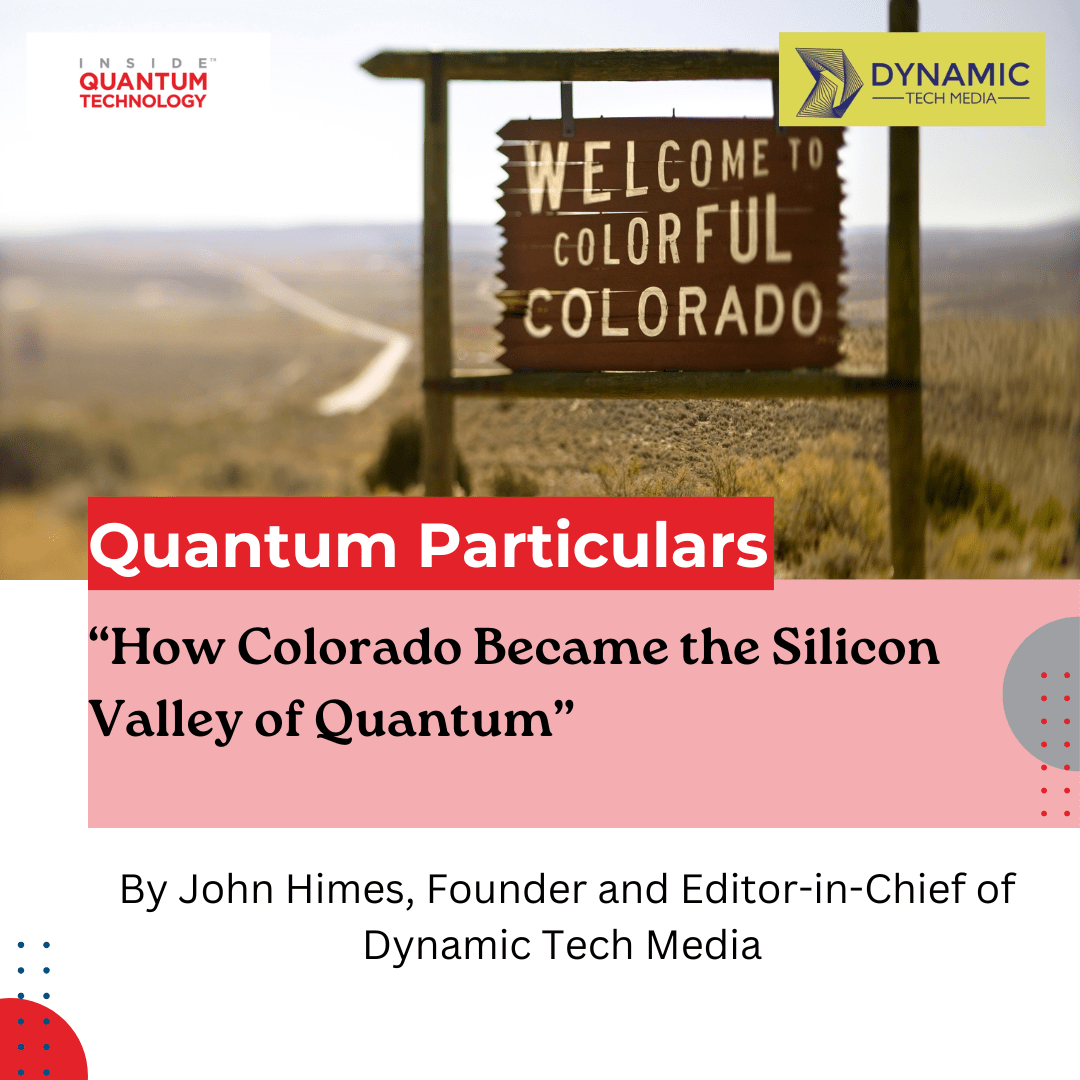Quantum Particulars Guest Column: “How Colorado Became the Silicon Valley of Quantum”

“Quantum Particulars” is an editorial guest column featuring exclusive insights and interviews with quantum researchers, developers, and experts looking at key challenges and processes in this field. This article, written by John Himes, Founder and Editor-in-Chief of Dynamic Tech Media, focuses on developing the Colorado quantum ecosystem.
Colorado is the place to be for quantum tech. The Front Range is exploding with innovation. How did we get here?
In the beginning…
There were the labs.
The University of Colorado (CU) Boulder—particularly its physics program—was the prime mover. CU was established in 1876, and when the National Institute of Standards and Technology (NIST) started looking for a location for its second campus in 1954, Boulder was the choice.
Plus the land was basically free at the time.
A third organization, JILA (formerly the Joint Institute for Laboratory Astrophysics), opened its doors in 1962. JILA’s founding paved the way for collaborations between CU Boulder and NIST.
Researchers at these institutions began working closely together. For instance, since NIST focuses on precision metrology and instrumentation, their work was crucial for advancing CU’s atomic, molecular, and optical (AMO) physics research.
These labs would continue to produce significant research, including three Nobel Prizes in Physics:
2001: Carl Wieman and Eric Cornell’s discovery of Bose-Einstein condensate (BEC). BEC is a state of matter in which a group of ultracold atoms act like a single particle. Its behavior is largely defined by the principles of quantum mechanics.
2005: John “Jan” Hall’s contributions to laser-based precision spectroscopy, including optical frequency combs, a kind of ruler for frequencies of light.
2012: David Wineland’s methods for measuring and manipulating individual quantum systems, such as laser-cooling and isolating then trapping cold ions. These methods are useful for creating atomic clocks and quantum computers.
These awards are emblematic of the caliber of research happening in Colorado to this day. These labs have made huge leaps forward in science and technology and set the stage for today’s Colorado quantum ecosystem.
Colorado’s quantum industry spins off.
As innovative research gets underway, people see opportunities for developing new companies.
One early example is a company that’s still in business after 45 years. Meadowlark Optics opened in 1979, creating polarization systems and components.
Then, in 2002, Vescent started making optical technologies that the founders–including Mike Anderson and Scott Davis–had worked on at JILA and the other labs. They remain a key part of Colorado’s quantum value chain, providing lasers, frequency combs, and control electronics to academia and industry.
Colorado’s quantum industry took off in 2007 with the founding of Infleqtion, previously called ColdQuanta. The company’s founder Dana Anderson also has roots at JILA. Infleqtion began using BEC and laser-cooled neutral atoms to develop technologies like atomic clocks and quantum computers. Today, with seven locations spread over three continents, they are one of the biggest players in the industry.
Then there’s the impact that government dollars, especially from the Department of Defense, had in this build-out. Small Business Innovation Research (SBIR) grants funded many of these early initiatives. The Air Force and the Space Force have a large presence in Colorado, and a network of local relationships likely played a role.
The gravitational pull intensifies.
As the quantum technology ecosystem began to ripen, a metaphorical gravitational pull took effect. Like attracts like. Top talent and investment dollars began pouring in. And by 2020, Colorado found itself host to one of the most vibrant quantum corridors in the world.
More quantum companies moved in. In 2022, Atom Computing decided to build its second facility in Boulder. While the company opened its first location in California, in many ways, coming to Colorado was like coming home: Dr. Ben Bloom, the company’s founder and CTO, earned his PhD from CU Boulder. He knew Colorado was the place to be for quantum.
Honeywell Quantum Solutions set up shop in Broomfield in 2016 to work on trapped-ion technologies. They then merged with Cambridge Quantum in 2021 to form Quantinuum. Like Infleqtion, they also have a global presence, but they chose Colorado as a headquarters.
Colorado’s quantum value chain
But what’s even more impressive than the number of quantum developers is that Colorado is organically growing a complete quantum value chain, going all the way down to the smallest components.
For instance, Octave Photonics is creating innovative nanophotonic integrated circuits that go into different hardware types. These include Vescent’s integrated laser systems. Then, those systems go into engineering quantum technologies.
We also saw Maybell Quantum exit stealth in 2022. This company, which produces dilution refrigerators for cryogenic cooling, is another part of the supply chain.
On the other end of the spectrum, we also see the development of hardware and applications at the top of the stack. Icarus Quantum, for example, is developing an entangled photon generator for quantum networking.
Colorado community is the foundation.
The story of Colorado’s quantum ecosystem is steeped in its community. The original labs keep churning out talent, but other local schools are also getting in on the action. The Colorado School of Mines began offering a quantum engineering program in 2020, while Front Range Community College added an optics technician program to serve the growing demand for skilled labor.
The community also came together to form Elevate Quantum, a consortium of over 70 organizations that fosters local collaboration and strengthens partnerships. The US Department of Commerce’s Economic Development Administration recently designated Elevate Quantum as a Regional Tech Hub. The fact that most of the organizations involved are here in Colorado is another sign that the state truly is the Silicon Valley of quantum.
As I uncovered this story during my work on the Colorado Tech Spotlight over the past several months, I realized we’re in the perfect place at the perfect time. The confluence of people, ideas, and technologies creates an ecosystem where innovation thrives, and collaboration is the norm. Many people also came to Colorado during the pandemic, bringing funding and ideas for innovation.
The truth is we can only make progress by working together as a community.
With my innovative team at Dynamic Tech Media, I strive to cover the community stories, conveying technical concepts and research advancements into engaging and human-focused narratives. We work to promote the industry’s larger growth through communications and marketing and want to make sure everyone understands the importance of Colorado’s ecosystem.
John Himes is the founder of Dynamic Tech Media, a digital marketing agency that specializes in creating content about complex technologies like quantum, photonics, and robotics.


















